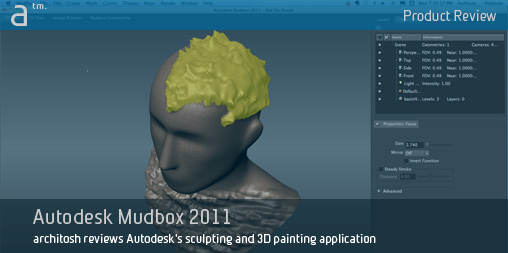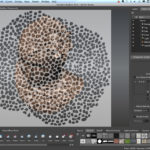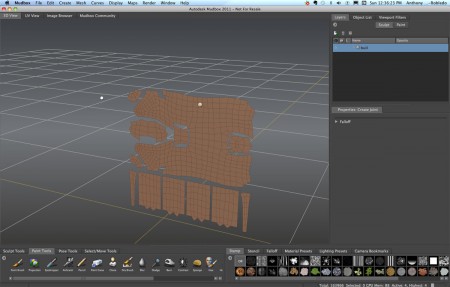Continued from page 1
When you apply a stencil, the image it is based on appears over the model. You then proceed to turn the model and sculpt as usual, this time the stencil’s effect transforms the model. (see image 05).
New in Mudbox 2011 is a set of posing tools in the Pose Tool tray. Rotation of joints is a common goal with characters and animals. With the bull in the image above and below (see image 06-07) you set a joint using the Create Joint tool.
The green highlighted zone represents the region to be affected by the joint. For example, in image 06 above, the bull’s front left leg is set up for rotation around what would be the natural joint within that animal–which you can see in image 07. You cannot use weighted skeletons directly in Mudbox 2011; however, you can import them from other programs like Maya via FBX and use them for posing.
What’s new in Mudbox 2011
The introduction above should give you an indication of what Mudbox is and how it works as well as touch on some items that are new. What follows is a focus on what is new in Mudbox 2011.
In version 2011 Mudbox now supports true 64-bit computing on the Mac platform. This requires the Snow Leopard version of Mac OS X . The benefits of 64-bit are greater memory support and increased performance, helping artists work with increased subdivision meshes and higher poly count models. Other under-the-hood improvements include a new graphics card check upon startup and improvements in FBX import/export.
A very valuable new feature in Mudbox 2011 is the new Flatten to UV Space command. It creates a copy of the model with vertex positions that are identical to the UVs on the original model so you can paint or edit textures on the flattened representation of the original. (see image 08 below).
You can also use the pinch or grab tools to make basic UV position edits of the vertices on the flattened 2D version. However, one item we noticed is that using the selection tools didn’t allow us to make selections of faces on the original model and have those carry over to the flattened version and vice versa.
Mudbox 2011 features new 3d painting enhancements but they are really image adjustment tools rather than true paint brushes. Blur, Dodge, Burn and Contrast adjust texture properties while Hue, Shift and Invert make adjustments to color properties. There are four new blend modes in Mudbox 2011’s paint layers: Multiple, Add, Screen and Overlay. Layer blend modes are non-destructive modifications to paint layers so they are useful for iterative experimentation.
Version 2011 also has a number of texture extraction improvements. A new Vector Displacement Map option now exists within the Extract Texture Maps window. VDMs are useful because they can represent sculpted features that are off-normal (like overhangs and undercuts). Think of a human ear. And normal maps and bump maps can now be displayed simultaneously on the model.
Other paint related improvements include the importation of paint layers to a channel, paint bleed preferences that set the bleed amount beyond the perimeter of UV shell borders, and improvements to the existing Mudbox to Adobe Photoshop roundtrip ability. It is now possible to export the multiple paint layers within a paint channel in one operation using the new Export Paint Channel to PDS…and Import Paint Channel from PSD options.
Finally, Mudbox 2011 has two new movie recording features. You can record your actions within the user interface using the Record Movie feature or you can output a turntable animation of your model and watch it rotate around 360 degrees. And a big new improvement in version 2011 is the new Maya-based Color Chooser which replaces the system level color choosers in prior releases.
Closing Comments
Autodesk Mudbox 2011’s primary competition is Maxon’s BodyPaint 3D, especially as both are fully cross-platform and thereby available to Mac 3D users. Autodesk sells it separately or within the Entertainment Creation Suite which combines either Maya or 3ds Max along with MotionBuilder.
Autodesk Mudbox 2011 is very accomplished software, laid out logically within a very professional and attractive user-interface. It works equally well on the Mac as it does on Windows and has an expanding set of “program to program” interactions making it very suitable for a variety of creative pipelines. This being said there are a few items that can make Mudbox better in the future beyond some of the comments above. The Flatten to UV space is a good start but true UV editing tools are absent. We would love to see that, and other minor items, (listed below) addressed in future versions.
In the meantime, Mudbox 2011 offers Mac 3d artists and pros a true 64-bit digital sculpting and 3d painting environment and should be at the top of your list for considerations for such programs.
Pros: very intuitive and easy to master 3d paint system; absolutely superb tutorial and help system; new 2D painting with flatten to UV space mode; new vector displacement; new 64-bit Mac support; Adobe Photoshop integration has improved, offering better roundtrip layer-editing support; new Maya-based color chooser; new poser tools
Cons: no true UV editing, there are no tools to do even basic UV editing; the new poser tools are limited, you cannot create weighted skeletons directly in Mudbox 2011
Advice: For those wishing to venture into 3d painting and digital sculpting Autodesk Mudbox 2011 is a great choice to consider alongside other options such as Maxon’s BodyPaint 3D.
Cost: 750.USD online direct. Other pricing options include bundles. For further information visit Autodesk’s Mudbox product page here. www.autodesk.com
To see other Architosh product reviews published prior to our new site, please visit this old Features page. We have an array of indepth product reviews across CAD and 3D industry spectrums.








Reader Comments
Comments for this story are closed